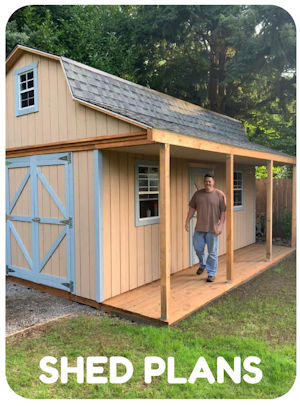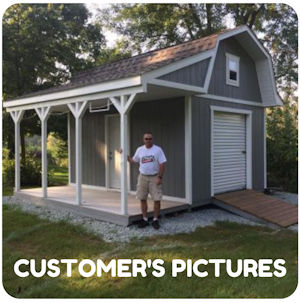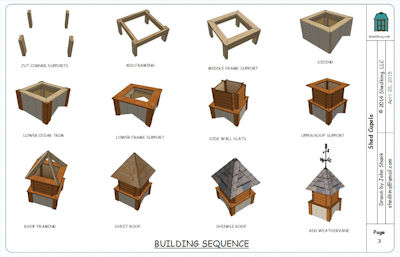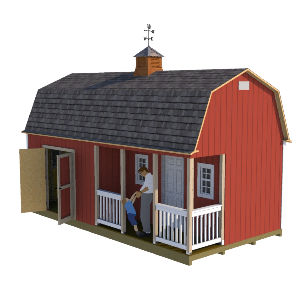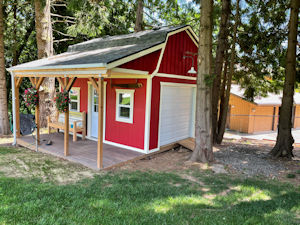Want to Save 30% off Any Shed Plan Purchase!
Signup For My 'Shed n Sight' Newsletter
and Get Your 30% off Promo Code To Use At Checkout.
- Home
- How to build a shed
- How to add solar power to your shed
How to Add Solar Power to Your Shed: A Friendly Guide for DIYers and Off-Grid Dreamers
 How To Add Solar Power To Your Shed
How To Add Solar Power To Your ShedHave you ever walked out to your shed and thought, "Man, it'd be nice if this thing had some power"? Whether you're running power tools, lighting it up at night, or charging batteries, solar power can be a game changer.
In this guide, I'm going to walk you through how to add solar power to your shed in a way that’s simple, practical, and totally doable — even if you’re just starting out. Whether you’ve already got a shed or you’re planning to build one, this article will help you figure out if solar is right for you, and how to make it happen.
Why Add Solar Power to a Shed?
Before we jump into the how-to, let’s talk about the why.
Adding solar power to your shed gives you:
- Independence from the grid – No need to run a power line or rely on your house’s electricity.
- Cost savings – Lower energy bills and no monthly fees.
- Environmental friendliness – Solar is clean, renewable, and silent.
- Flexibility – You can install it almost anywhere — even in remote areas.
- Self-sufficiency – You’re in control of your own energy.
Whether you're living off the grid, trying to be more eco-conscious, or just want a convenient power source for your backyard workspace, solar is a smart solution.Is Solar Right for Your Shed?
Please note: There are text and image links to my store on amazon. If you click on them and make a purchase, I will make a small commission. This does not however affect the price you pay.
Is Solar Right for Your Shed?
 Is solar Power Right For Your Shed?
Is solar Power Right For Your Shed?Here are a few things to think about:
- Do you get plenty of sunlight? If your shed sits in deep shade all day, solar might not be worth it.
- What will you power? Lights? Tools? A mini fridge? Your energy needs will determine the size of your system.
- Do you want to go off-grid completely? Some people add solar to avoid any hookup to traditional electricity.
- What’s your budget? Solar setups can range from $200 to $2,000+, depending on your needs.
If you're nodding along to most of these, then let's dig in.
What You Need for a Solar Shed Setup
To add solar power to your shed, you’ll need a few basic parts. Here's a quick breakdown:
1. Solar Panels
 400watt Rooftop Solar Panels
400watt Rooftop Solar PanelsThese collect energy from the sun. You can mount them directly to your shed roof or on a separate stand.
Tip: Look for monocrystalline panels if you want maximum efficiency in a smaller space.
2. Charge Controller
This little box controls how much power goes from your panels to your battery, so you don’t overcharge (or kill) it.
3. Battery (or Batteries)
This is where you store your solar power. It lets you use power at night or on cloudy days.
Best choice: Deep cycle 12V batteries, like AGM or lithium iron phosphate (LiFePO4).
4. Inverter (optional)
If you want to run standard 120V appliances (like power tools or lights), you’ll need to convert that 12V battery power into AC electricity. That’s what an inverter does.
5. Wires, Fuses, Mounts, and Hardware
 Tim's Solar System Setup (Tim is one of my customers).
Tim's Solar System Setup (Tim is one of my customers).You’ll need the right gauge wires and safety gear to connect everything safely.
Off Grid Solar System Options for Sheds
Let’s look at a few setups — from basic to advanced — so you can match your system to your needs.
Basic Lighting Setup (Under $300)
Perfect for: Lighting, USB charging, small fans Medium Power Setup ($500-$1,000)
- One 100-watt solar panel
- 10A charge controller
- One 100Ah battery
- Small 300-watt inverter (optional)
- LED lights and USB outlets
Perfect for: Lights, laptop, small tools, WiFi router⚡ Heavy-Duty Off-Grid System ($1,200+)
- Two or more 100-watt panels
- 20-30A charge controller
- Two 100Ah batteries
- 1,000-watt inverter
Perfect for: Running a mini fridge, power tools, even an A/C unit for short periods
- 400W+ of solar panels
- MPPT charge controller (more efficient)
- Four 100Ah batteries or two large LiFePO4 units
- 2,000-watt inverter
This would be ideal for a shed that’s also a cabin or tiny house.
Solar Panel Installation Tips
Installing solar panels is easier than you might think. Here are some tips to keep you on the right track:
- Face them south (in the Northern Hemisphere) for maximum sunlight.
- Tilt your panels at the same angle as your latitude for year-round performance.
- Mount securely using Z-brackets or a tiltable frame.
- Protect the wiring using conduit or cable clips.
Bonus Tip: If your shed roof isn’t strong or sunny enough, ground-mounting your panels might be a better option.
Wiring It All Together
Wiring your off grid solar system is just like building with LEGO — if LEGO carried electricity. You’re just connecting everything in the right order:
- Panels → Charge Controller
- Charge Controller → Battery
- Battery → Inverter (if you’re using one)
Use inline fuses for safety and follow the wiring instructions that come with your gear.
Real-World Example
Let me share what I did with my own shed.
I started small — just wanted some lights and a way to charge my drill battery. I grabbed a 100W Renogy solar kit online, hooked it up with a deep cycle marine battery, and wired in a couple LED shop lights and a USB outlet. The whole thing took me a weekend to install and cost under $300.
A year later? I upgraded to 300W of solar, added two more batteries, and now I run a mini fridge, my tool battery charger, a fan, and even a laptop charger. It’s been a total game changer. And the best part? I haven’t paid a dime for electricity out there since.Helpful Add-Ons and Upgrades
 Renogy 300w Solar Panels
Renogy 300w Solar PanelsOnce your system’s up and running, you might want to add:
- Battery monitor – shows how much juice you’ve got left
- Motion lights – great for security
- DC appliances – more efficient for solar setups
- Expandable kits – let you add panels or batteries as needed
Common Mistakes to Avoid: Is It Worth It?
- Underestimating power needs – Always go a little bigger than you think.
- Using car batteries – These aren’t made for deep cycling and won’t last.
- Poor wiring – Use the right gauge wires and secure all connections.
- No ventilation – Batteries can get hot. Make sure they have airflow.
Is Adding Solar Power To Your Shed Worth It?
Absolutely. Adding solar power to your shed is one of the most satisfying DIY projects you can take on. You get energy independence, a useful workspace, and peace of mind — all while helping the environment.
Sure, there’s a learning curve, but once you get it dialed in, it just works. And there’s something awesome about flipping on a light that’s powered by the sun.Final Thoughts
So if you’re wondering how to add solar power to your shed, the answer is: start small, think big, and go step by step.
Whether you're powering a few lights or building out a full off grid solar system, it’s all doable. With a bit of planning, some basic tools, and a good weekend, you can create a self-powered shed that works for years to come.
You don’t need to be an electrician or a solar expert. You just need the right info — and hopefully, this guide gave you exactly that.
Got questions? I’d love to hear what you’re building — shoot me a message or drop a comment below!
Have A Great Story About This Topic?
Do you have a great story about this? Share it!
Monthly DIY
Shed-in-sight
Newsletter
Subscribing will get you discounts on shed plans, monthly updates, new shed design ideas, tips, exclusive discounts on shed building resources and tools. Learn more here.
Recent Articles
-
Thinking of adding solar power to your shed or off grid shed house?
Jul 14, 25 10:00 PM
Understanding the ins and outs of adding solar power to your shed or off grid shed house or cabin -
Free Cupola Plans For Your Neat Shed
Jul 12, 25 09:34 PM
Use these cupola plans to build a neat cupola and spruce up your beautiful shed. -
Selling shed plans since 2010 to over 28,000 satisfied customers!
Jul 09, 25 06:56 AM
All types of shed plans for gable, barn, saltbox, and lean to style sheds small and large that can be used for storage, shed to house, workshops and more.
My You Tube Videos




